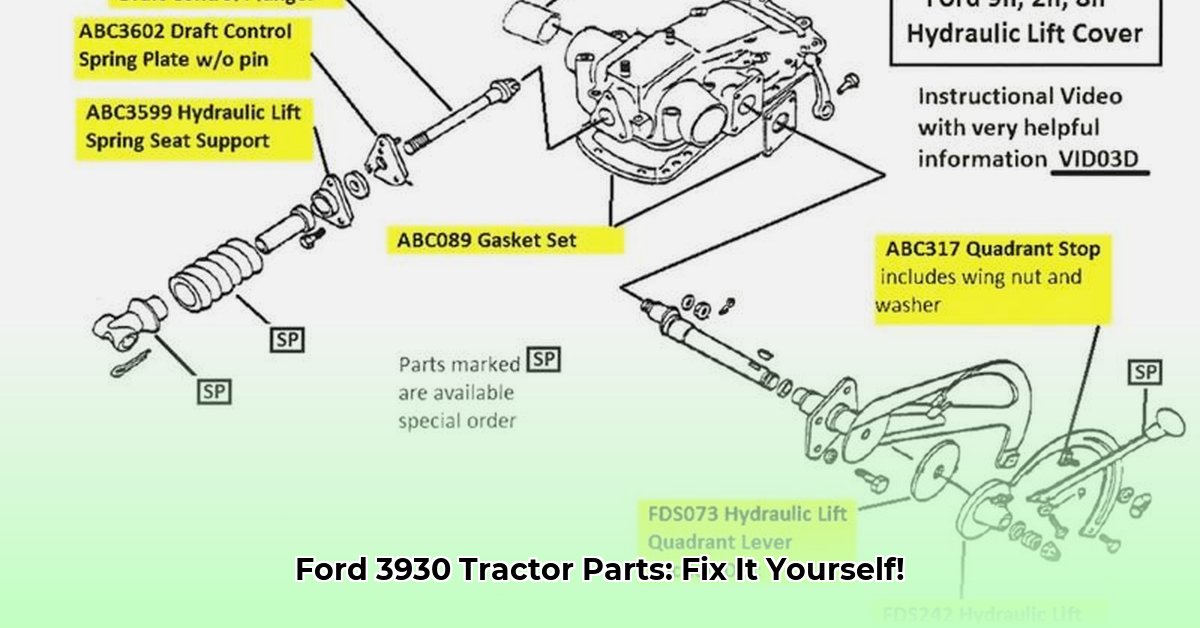
Decoding Your Ford 3930 Tractor Parts Diagram: A Step-by-Step Guide
Understanding your Ford 3930 tractor's parts diagram is essential for efficient maintenance and repairs. This guide provides a clear, step-by-step approach to navigating this crucial resource, whether you're a seasoned mechanic or a first-time user. Have you ever been frustrated trying to identify a specific part? This guide will eliminate that frustration. For additional diagrams, check out this helpful resource: Ford Tractor Parts Diagrams.
Step 1: Identifying the System. Ford 3930 parts diagrams typically organize components by system (engine, transmission, hydraulics, etc.). Before beginning, pinpoint the area needing attention. Is it a hydraulic leak, engine trouble, or a problem with the PTO? Focusing your search dramatically improves efficiency.
Step 2: Part Number Identification. Each part on the diagram is assigned a unique number. The accompanying parts key provides a description for each numbered part. This number is crucial for ordering replacements. Accurately recording this number prevents delays and ordering errors.
Step 3: Utilizing Exploded Views. Many diagrams use “exploded views,” showing disassembled parts and their arrangement. These graphical representations greatly aid in understanding component relationships and reassembly. Have you ever struggled to put something back together? Exploded views are your solution.
Step 4: Understanding Component Interconnections. Focus not only on individual parts, but also on how they interact. A single faulty part can impact others. Understanding these relationships enhances troubleshooting capabilities.
Step 5: Sourcing Replacement Parts. Once you've identified the part number, you need to source the replacement. You have two key choices: Original Equipment Manufacturer (OEM) parts or aftermarket parts.
OEM vs. Aftermarket Parts: A Detailed Comparison
Choosing between Original Equipment Manufacturer (OEM) and aftermarket parts for your Ford 3930 influences both short-term costs and long-term reliability. The upfront price difference is often substantial. Do you prioritize initial cost savings or the long-term benefits of superior quality?
| Feature | OEM Parts | Aftermarket Parts |
|---|---|---|
| Cost | Higher | Lower |
| Quality | Typically superior; guaranteed fit | Variable; quality may be inconsistent |
| Warranty | Usually longer and more comprehensive | Often shorter or nonexistent |
| Availability | Generally readily available | Availability may vary, especially for older parts |
| Longevity | Generally longer lifespan | Potentially shorter lifespan |
This table highlights the key differences. Choosing between OEM and aftermarket parts requires careful consideration of your specific needs and budget.
Preventative Maintenance: Extending Your Tractor's Lifespan
Preventative maintenance is significantly more cost effective than emergency repairs. Regularly consulting your parts diagram simplifies this process. What percentage of tractor downtime is due to preventable issues? A significant number, according to industry experts.
Fluid Levels: Regularly check coolant, hydraulic fluid, and transmission fluid levels. Low levels can indicate leaks or other problems. This simple check can prevent catastrophic damage.
Filter Changes: Regularly inspect and replace air, fuel, and oil filters. Clogged filters can severely impact performance and engine life. How frequently should you change your filters? Check your owner's manual for the recommended schedule.
Tire Pressure: Maintaining correct tire pressure is critical for performance, fuel economy, and safety. Improper inflation can lead to premature tire wear and reduced efficiency.
These steps, combined with regular reference to your parts diagram, are vital for maintaining your Ford 3930's health and performance.
Long-Term Cost Analysis: OEM vs. Aftermarket
The decision between OEM and aftermarket parts hinges on a long-term cost-benefit analysis. Simply comparing initial prices is insufficient. A comprehensive approach considers several factors:
Part Lifespan: How long will each part last? A longer lifespan, even with a higher initial cost, can save money in the long run.
Warranty Coverage: A comprehensive warranty can protect against premature failures. Compare warranty periods and conditions for both options.
Labor Costs: Factor in the cost of labor for installation. A higher-quality part might require less labor over time due to increased longevity.
Downtime Costs: Consider the cost of tractor downtime. Reliable parts minimize disruptions and associated financial losses.
By performing a thorough cost analysis, you can make an informed decision about which option—OEM or aftermarket—truly provides the best value. This detailed approach ensures that your investment yields long-term efficiency and cost savings.